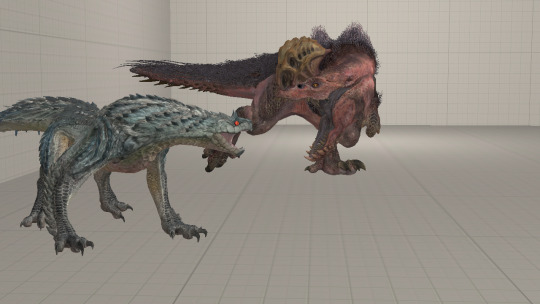Text

Meet the Bathygrell-A small monster of the underwater ruins calling back to times long forgotten . Its ventral side is bioluminescent, akin to other residents of this area, and it bleeds blue blood. Very rarely caught in moga village fishing attempts.
8 notes
·
View notes
Text

Semi realistic Tyranitar and Aggron
4 notes
·
View notes
Text


Meet the wanibek
A small leviathan that the people of moga village have developed an unusual relationship with.
Used to assist in fishing, they are often equipped with a loose snare surrounding their jaws, allowing them to eat small fish,but makes them unable to consume the larger fish before the fishermen can get them.
The top one is a baby that makes chirping noises akin to real crocodilian babies, and can be carried around in their parent’s jaws.
They are small relatives of leviathans like Lagiacrus and Agnaktor, and like their pelagic cousin, they possess electroreception(although they cannot produce electricity). This is helpful for underwater hunts, as they can sense the presence of a large monster in murky water or if they’re hidden.
Engravings are often written into their horns, and these are the mounts an aspiring moga village hunter will use to traverse the many islands that make up this region of the world.
14 notes
·
View notes
Text

Delex reinterpretation based off of that concept art where they were seemingly jhen Mohran juveniles. The fins on this specimens back will be replaced with a rocky spine when it grows up.
15 notes
·
View notes
Text

Baby ceadeus, and a small Nakarkos related mimick

11 notes
·
View notes
Text
My reinterpretation of Najarala-the twisting snake wyvern


-Is now the apex monster of the primal forest
-Roar animation is similar to that of Dalamadur albeit closer to the ground
Design changes
-More snake like head
-Red, unblinking eyes(when slain or knocked over its eyes go white like Dalamadur)
-Hooded neck
-Sonic scales more like keeled scales, closer to the body to make burrowing easier
-Retractable fangs like a viper, bluish mouth interior
-Hindlimbs turned into stubby spurs
-Tail has a vaguely macuahuitl like shape
Fight changes
-More focused on its scale production and paralysis(burrows to move to faraway areas akin to tetsucabra)
-Keeps itself closer to the ground normally, assuming the coiled position for particular attacks
-It’s chest is breakable
-It can shake its tail rattle to make its sonic scales explode
-If the tail is cut off it will have to resort to a roar
-Forelimb swipe attack
-Has an attack where it slams its jaw into the ground(it can inflict paralysis)
-Slither attack has a telegraph of it coiling up
-Sweeping tail drag where it slams its tail into the ground
Miscellaneous
-It’s lair is a ground sloth esque burrow(the entrance corkscrews) that has sound echo, thus making the range of its sonic scale bursts larger
-Environmental traces include footprints and pieces of shed skin(finding these will give you a chance of collecting a najarala scale)
-Idle animation/when it’s trying to find the hunter has it flick it’s forked tongue
-When low on stamina it will paralyze and kill Slagtoth before swallowing them whole like a snake
14 notes
·
View notes
Text

Semi realistic Rathalos and Rathian.
21 notes
·
View notes
Text




Some sfm shitposts. I have made so far. The bearded elder is rather colorful on its underside.
1 note
·
View note
Text
Hunger

5 notes
·
View notes
Text










Part 5
3 notes
·
View notes
Text










Part 4
1 note
·
View note
Text










Part 3
1 note
·
View note
Text









Batch 1 of my shitposts. Dalamadur really is the king under the mountain lol.
0 notes

















